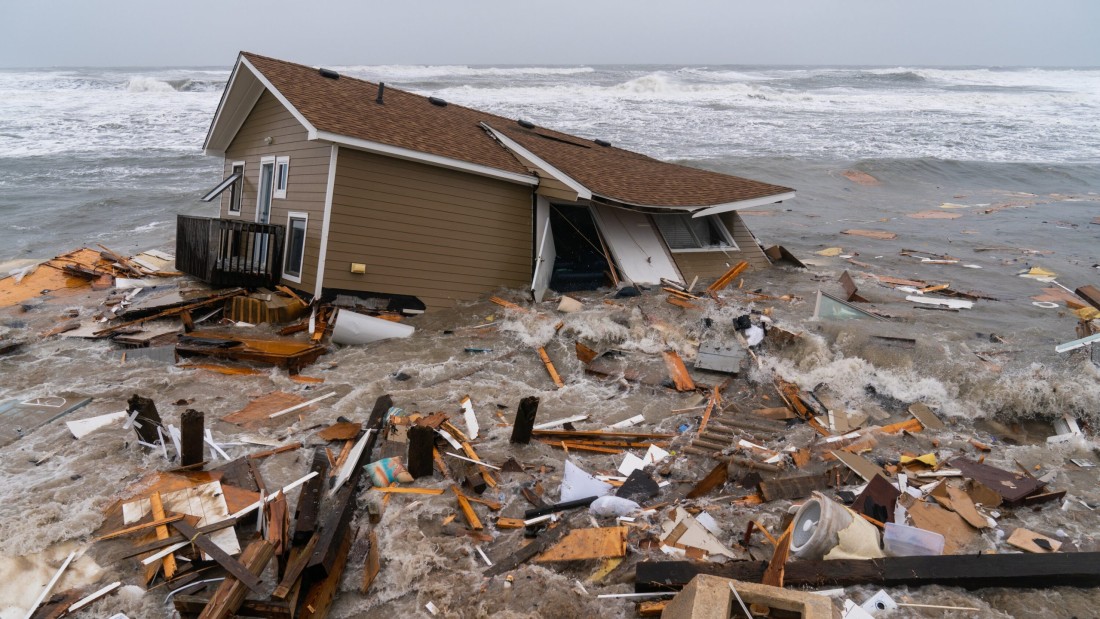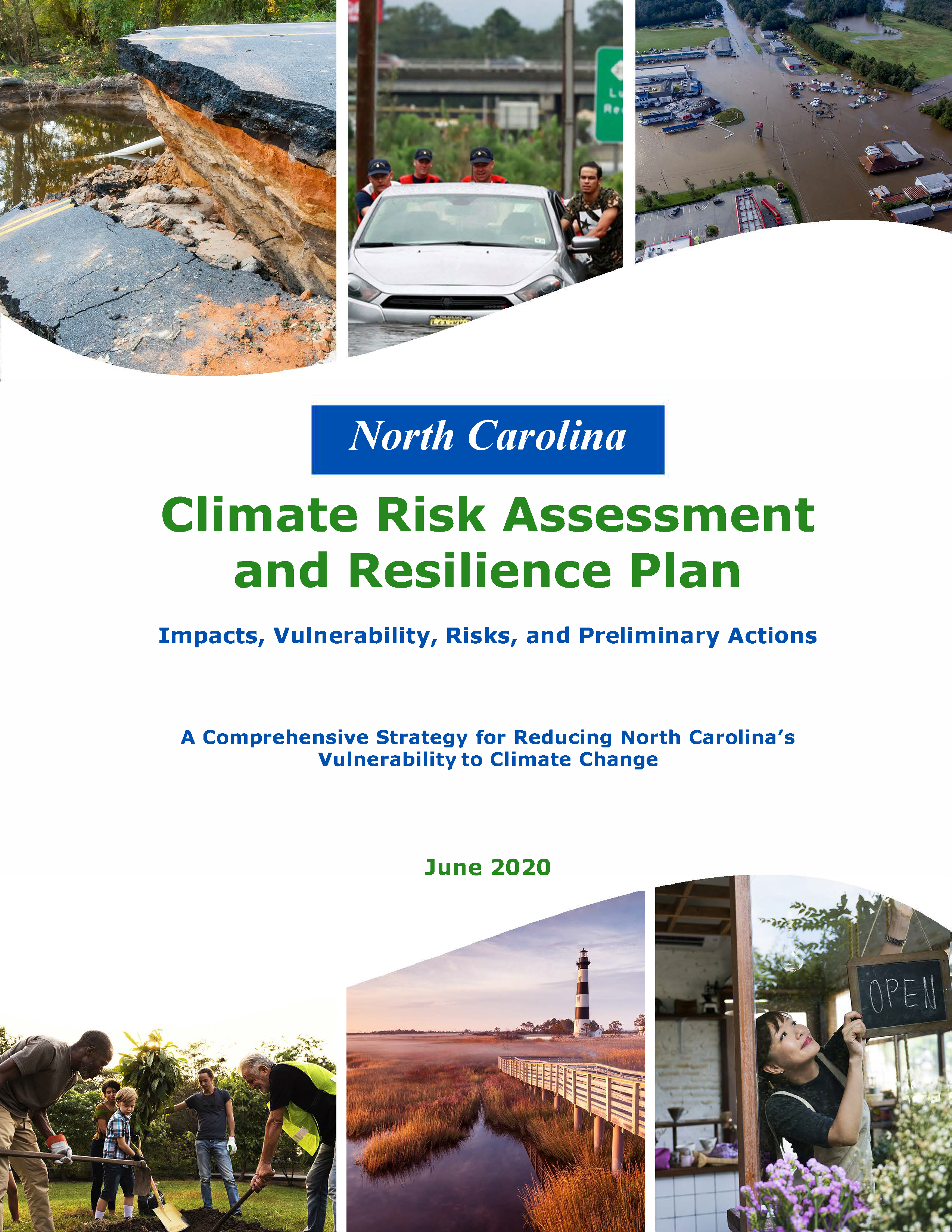Climate in North Carolina
Washouts of NC 12 on the Outer Banks. Wildfires in Western North Carolina. Rising urban heat in the Piedmont. Sound familiar? North Carolina has seen all these events in recent years. What do they have in common? They are all intensified by a changing climate.

Sea levels are rising. Weather is becoming more violent and unpredictable, with more powerful storms, rainfall shifts, flooding, hotter summers, and drought leading to more wildfires. These changes are causing increasing human fatalities, infrastructure damage, property destruction, food shortages, and ecosystem changes. The most socially vulnerable human populations are often the greatest at risk from these forces, and extreme weather events are displacing growing numbers of people. Climate experts warn that time is running out to limit global warming to 2.0°C (2.7°F) and prevent large-scale negative impacts (IPCC 2023). Major emissions reductions will be needed across all sectors to cause global greenhouse gas discharges to peak before 2025 and be reduced by about 43% by 2030 (IPCC 2023). Some strategies focus on mitigation to lower greenhouse gas emissions and reduce the extent the climate changes. Other techniques focus on adaptation to reduce the harmful effects on our communities. Both approaches will be needed in the years ahead and can make our communities healthier, more equitable, and more resilient in the process.
The Challenge
Climate impacts vary across North Carolina, with the prospect of sea level impacting the coast, more intense hurricanes affecting the coastal plain, increased landslides and drought in the mountains, and more intense thunderstorms and flooding throughout. The challenge is exacerbated by rapid growth and development in the state, potentially putting more people and property in harm’s way. In recent years, North Carolina has worked to establish a strong state framework for addressing climate change. In 2018, N.C. Governor Roy Cooper issued Executive Order Number 80 to catalyze a major new state effort to address the issue. This led to preparing the North Carolina Climate Risk Assessment and Resilience Plan: Impacts, Vulnerability, Risks, and Preliminary Actions in 2020 to summarize climate impacts and risks in the state and establish the North Carolina Resilience Strategy to address them. In addition, it designated the N.C. Office of Recovery and Resilience (NCORR) as the lead state entity to implement resilience measures.
Potential Responses
Short-Term
- Develop local Climate Action and Resilience Plans
- Integrate Climate Action recommendations into local hazard mitigation plans and comprehensive plans
- Set local and regional greenhouse gas reduction goals
- Create local and regional Climate Action Teams to support and track implementation
- Create a regional Climate Justice Task Force
Medium-Term
- Coordinate with state and federal partners to implement climate-positive and climate-resilient development strategies and share best practices
- Implement measures in this report for energy, water, food security, and circular economy
- Track progress toward reducing greenhouse gas emissions
- Track climate impacts and assistance to socially vulnerable populations
Long-Term
- Continue systematic reduction of local, regional, and state carbon footprint to achieve net zero carbon emissions
- Establish North Carolina as a leader in developing and implementing climate-resilient solutions
- Collaborate with educational institutions and employers to build a workforce skilled in climate solutions
Key Stats
- After adjusting for inflation, North Carolina experienced 112 weather/climate billion-dollar disasters between 1980 and 2023, with an annual average of 2.5 events for the whole period and 6.2 events a year over the last five years (NOAA).
- Sea level rose almost 8 inches at Wilmington from 1935-2018 and almost 7 inches at Duck from 1978-2018 (C. Institute for Climate Studies 2020).
- From 2016 to 2021, the United States experienced 177 weather-related disaster events, which displaced 1.5 million people on average each year (IDMC 2022).
Example: Town of Beaufort Resilience Program
The Town of Beaufort, NC, is taking several measures to increase its resilience, reduce its carbon footprint, and better protect itself from the growing impacts of climate change. These include working with the NC Department of Transportation to install stormwater bioretention cells along Cedar Street to capture and filter stormwater and developing a public-private partnership to fund a new downtown waterfront bulkhead sized for water levels in 100 years. In addition, the Town adopted a Resilient Beaufort plan that documents the town’s vulnerability to flooding and identifies several additional implementation projects, such as building a living shoreline to intercept storm surges and launching a program to elevate historic structures. To reduce its carbon footprint, the Town is encouraging the adaptive reuse of existing buildings, like a former elementary school that is being converted to condominiums, thereby avoiding emissions from embodied carbon needed to make new construction materials. In these ways, the Town is working to reduce its contribution to climate change and better protect itself from its impacts.
Click here to complete our survey about North Carolina drivers of change!
References
American Planning Association. Climate Change Policy Guide. 2020.
Bucchin, Matt and Aaron Tuley. Planning for Climate Mitigation and Adaptation. PAS Report 601, American Planning Association. 2022.
Georgetown University. Equitable Adaptation Legal and Policy Toolkit.
Geos Institute. Climate Ready Communities: A Practical Guide to Building Climate Resilience. 2019.
International Panel on Climate Change (IPCC). Climate Change 2022: Impacts, Adaptation, and Vulnerability. 2022.
N.C. Institute for Climate Studies. North Carolina Climate Science Report. 2020.
NOAA. U.S. Climate Resilience Tool Kit.
NOAA National Centers for Environmental Information. State Climate Summaries 2022: North Carolina. 2022.
PBS. North Carolina Climate Stories Video Series. UNC Institute for the Environment. 2017.
State of North Carolina. North Carolina Climate Risk Assessment and Resilience Plan. 2020.
UNC School of Government. N.C. Historic Resilience Project.
U.S. Department of Agriculture, U.S. DOD Readiness and Environmental Protection Integration Program, and U.S. Department of the Interior. Eastern North Carolina Sentinel Landscape Profile. 2022.
U.S. Department of Defense. DOD Climate Resilience Portal.
U.S. Environmental Protection Agency (USEPA). Climate Change Website.
U.S. Global Change Research Program. Fifth National Climate Assessment. 2023.



